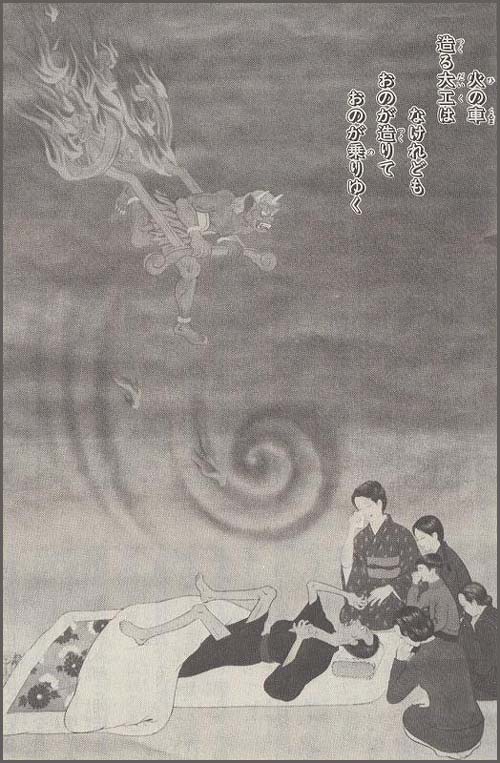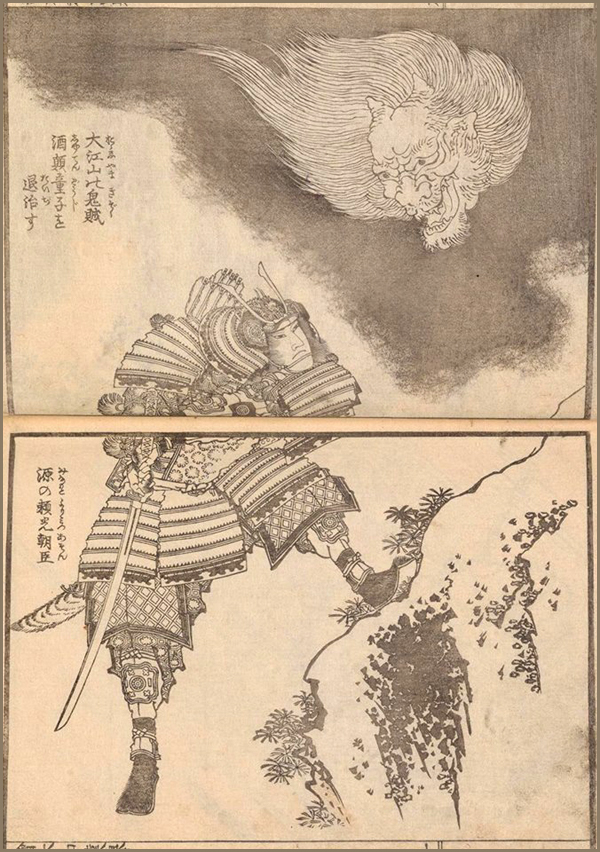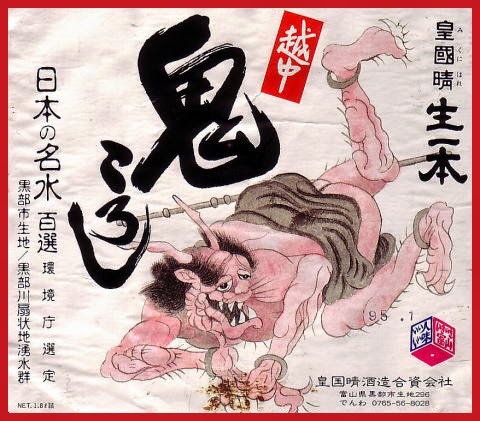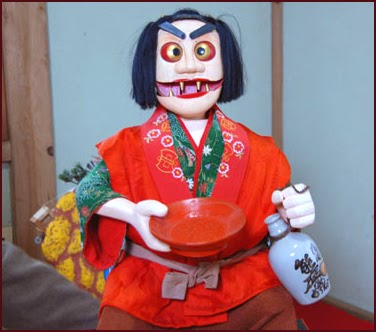. yookai, yōkai 妖怪 Yokai monsters - Introduction .
. kozoo 小僧と伝説 Kozo, Legends about temple acolytes and youngsters .
:::::::::::::::::::::::::::::::::::::::::::::::::::::::::::::::::::::::::::::::::::::::::::::::::::::::::::::::::::::::::::::::::::::::::::::::::::::::::::::::::::::::::::::::::::
- Toofu Kozoo, Tōfu kozō 豆腐小僧 Tofu Kozo, The Tofu Boy -
. Bean curd ( 豆腐 toofu, Tofu, Dofu) .
- Introduction -
Tofu is made made by coagulating soy milk, and then pressing the resulting curds into blocks.

CLICK for more photos !
..............................................................................................................................................
- quote
Tōfu-kozō – The Tofu Boy
Zack Davisson
On a dark and stormy night Edo night, if you should happen to turn around and see a giant baby dressed in an enormous bamboo hat and carrying a wiggly block of tofu festooned with a maple leaf, don’t panic. Despite the strange appearance, it is only Tofu Kozo, one of the most harmless of all of Japan’s bizarre yokai tribe.

Who is Tofu Kozo?
One of Japan’s most popular yokai, the name Tofu Kozo is most commonly translated as “tofu boy” or “tofu kid,” although a more literal—albeit clumsy—translation would be “tofu young Buddhist priest.” But the Buddhist associations don’t run any deeper than the name, with “kozo” being a common term for young boys in Japan.
Tofu Kozo generally appears as a small boy, or even a baby, in a giant, conical bamboo rain hat and a traditional kimono. The kimono can be plain, or highly decorated with daruma figures, red rockfish, horned owls, and taiko drums, all of which were thought to be talismans against small pox during the Edo period. As the same suggests, Tofu Kozo are never seen without a plate of tofu, which is decorated with a single maple leaf impression.
Lacking any special powers or features other than appearance, Tofu Kozo is said to wander through deserted city streets at night, or during the rain. Generally shy and timid, Tofu Kozo sometimes likes to sneak behind humans and follow them through the streets.
There is little agreement about Tofu Kozo amongst writers. Some say that there is only one Tofu Kozo, and that he is a sort of yokai prince, the son of the yokai supreme commander Mikoshi Nyudo and his wife the Rokurokubi. Some say that tofu kozo are nothing more than errand boys for the yokai, rushing back and forth on endless tasks.
From the Showa era and up, there have been accounts of Tofu Kozu as meeting people on rainy streets at night, and offering up some delicious tofu. Anyone who eats the tofu finds their body growing with mold from the inside until they die. Yokai researchers Kyougoku Natsuhiko and Yamaguchi Bintaro trace this legend as having been invented for for childrens’ books in the Showa era to give the Tofu Kozo a bit more of an edge for modern readers.
One the opposite side, in modern Japan therapists have been using Tofu Kozo as a yokai who gets bullied by other yokai, and is used in anti-bullying therapy and education.
The Origin of Tofu Kozo
Tofu Kozo has the unique status of being Japan’s first modern, city-bred yokai. Unlike other yokai that sprang from ancient and rural Japan, the Tofu Kozo has no folklore heritage, no appearances in traditional folktales or legends. He arrived fully formed suddenly during the Anei era (1772-1781), where he quickly became a popular character for picture books, kabuki performances, toys, advertisements, cookbooks, and yellow-covered kiboshi illustrated stories.
There are several theories as to the origin of Tofu Kozo. One aspect is tofu itself. The urban Edo period saw the rise of tofu as a popular food source, cheap and nutritious. One picture book of the time, Edo Meisho Zue (江戸名所図会) “Collection of Pictures of the Famous Places of Edo” by Hasegawa Settan, shows tofu dealers wearing the iconic conical bamboo hat as they travel the streets back and forth with their wares. Other illustrations from the period show yokai like tanuki and kappa carrying tofu, and it is speculated that some enterprising tofu dealer might have created Tofu Kozo as an advertising character for their shop, only to see the character’s popularity run away from them.
Mizuki Shigeru gives the location of Tofu Kozo as Satsuma province, modern day Kagoshima prefecture, although the character is seen all over Japan. During the Edo period, when the 100 candle storytelling game of Hyakumonogatari Kaidankai was popular, game players and storytellers were always on the lookout for new yokai stories to tell, and it is likely that the legend of Tofu Kozo was created and expanded upon during numerous storytelling sessions.
The first known print appearance of Tofu Kozo is in the 1777 kiboshi illustrated book “Bakemono Shiuchi Hyoban-ki” (妖怪仕内評判記; “Commentary on Notable Events of the Yokai”), written by Koikawa Harumachi. A few years later in 1782, he appeared in a popular tofu cookbook called “Tofu Hyakuchin” (豆腐百珍; “The 100 Curiosities of Tofu”) by Hitsujun Ka. The character continued to be popular through the Meiji era.
The Many Faces of Tofu Kozo
Because there is no traditional origin for Tofu Kozo, artists have depicted him in varying ways over the years. Early descriptions describe him as having an enormous head, like an overgrown baby. Koikawa Harumachi described him this way in “Bakemono Shiuchi Hyoban-ki,” and the artist Kitao Masayoshi even named him Ogashira Kozo, meaning “Big Head Boy,” in his 1787 picture book “Bakemono Chakutōchō” (夭怪着到牒). For a short time, it was popular to draw Tofu Kozo as having only one eye, but this fad soon faded and by 1853 Tofu Kozu was drawn looking like a normal young boy, as seen in the illustrated book “Kyoka Hyakumonogatari” (狂歌百物語).
An obvious relative of Tofu Kozo is Hitotsume Kozo, meaning the One-Eyed Boy. Although Hitotsume Kozo is an older, more traditional yokai, over the years the two have come to resemble each other as their stories and appearances merged. This has caused researchers to postulate that they are the same yokai. But while they have had obvious influences on each other—and are depicted as cousins in many modern yokai stories—they are generally considered to be separate characters.
- source : Zack Davisson
- source : National Diet Library -
..............................................................................................................................................
- quote -
Tōfu-kozō (豆腐小僧, literally tofu boy) is a yōkai of Japan, and is a yōkai that takes on the appearance of a child possessing a tray with tōfu on it. It is a yōkai that frequently appears in the kusazōshi and kibyōshi and kaidan books from the Edo period, and from the Bakumatsu to the Meiji period, people have become familiar with them as a character illustrated on toys[2] such as kites, sugoroku, and karuta. They can also be seen in senryū, kyōka, e-hon banzuke (pamphlets that introduce the contents of a shibai), and nishiki-e, etc.

"Ōjidai Karano Bakemono" by Shuntei Katsukawa.
An example of a tōfu-kozō with one eye.
. . . Based on the folk belief that hitotsume-kozō like tōfu, and since there was the card in yōkai karuta called "Boy with His Toungue Out Licking a Tōfu (した出し小僧のとうふなめ?," as well as senryū poems such as
"behind the tōfu shop there is a one-eyed boy
(豆腐やのうらは一つ目小僧也 to-o-fu-ya-no/u-ra-ha-hi-to-tsu-me/ko-zo-u na-ri)"
and "
tōfu-kozō are one-dice-eyed fellows wearing kasa
(笠のうち眼は一ツ賽の目の奴んも化す豆腐小僧は),"
it has been pointed out that tōfu-kozō would thus be no more than an alternate name for hitotsume-kozō, but since there are many tōfu-kozō that don't have one eye, there is also the claim denying that they are the same as hitotsume-kozō, and that tōfu-kozō and hitotsume-kozō were created separately.
In any case, there are many parts that are still unclear, and there is still research going on about how tōfu-kozō developed.
- - - More in the WIKIPEDIA !
katame 片目 "with one eye" could well be a pun with katame 固め hard tofu
.......................................................................
. Mikaribaba, Mikari Basan 蓑借り婆さん / ミカリバアサン
"old hag Mikari" .
And her companion, me hitotsu kozo 目一つ小僧 (Hitotsume Kozo)
. 一つ目達磨 hitotsume Daruma - 白隠 Hakuin .
Hakuin teaches us that we can hear the sound of one hand or view the world with one eye ...
. me hitotsu kozoo 目一つ小僧 and Yamanokami .
from Shizuoka
.......................................................................
. Hitotsume Kozoo 一つ目小僧 Hitotsume Kozo - Young Monk with One Eye .
and
一つ目小僧地蔵 Hitotsume Kozo Jizo

:::::::::::::::::::::::::::::::::::::::::::::::::::::::::::::::::::::::::::::::::::::::::::::::::::::::::::::::::::::::::::::::::::::::::::::::::::::::::::::::::::::::::::::::::::
- flying tofu -
雁鴨は我を見捨てゝ去りにけり
豆腐に羽根の無きぞ嬉しき
Goose and duck
leaving, I am out of luck
happily, I see
My tofu, lacking wings
cannot abandon me!
. Ryokan / Ryookan 良寛 (1758-1831) .
. Flying Tofu, discussion with Robin D. Gill .
Kyoka, Japan's Comic Verse: A Mad in Translation Reader
By Robin D. Gill
:::::::::::::::::::::::::::::::::::::::::::::::::::::::::::::::::::::::::::::::::::::::::::::::::::::::::::::::::::::::::::::::::::::::::::::::::::::::::::::::::::::::::::::::::::
Tofu Kozo and Daruma san !

:::::::::::::::::::::::::::::::::::::::::::::::::::::::::::::::::::::::::::::::::::::::::::::::::::::::::::::::::::::::::::::::::::::::::::::::::::::::::::::::::::::::::::::::::::
- - - - - Legends with tofu 豆腐伝説 - - - - -
The fox has a special relationship to tofu, especially fried tofu,
abura age 油揚げ.
They will be collected in a separate entry.
. kitsune 狐 fox legends .
..............................................................................................................................................
........................................................................... Tengu 天狗 the long-nosed goblin
Gunma 群馬県
Once upon a time
a Tengu turned himself into a boy apprentice and lived at the temple Kashozan. Once he went on an errand to 沼田 Numata, which takes about 30 minutes. The head priest had asked him in the morning to go and get some fresh tofu.
(今日できの豆腐 - kyo deki no tofu )
But today of all days, the boy returned only late in the evening.
When he arrived, the priest aksed him what had happened.
"Well, you told me to go to Kyoto to get some Tofu, so I went there!" (Being a Tengu, he could fly . . .)
(京できの豆腐 - Kyo (Kyoto) deki no tofu)
This is a pun on the sound of KYO.
. Kashozan 迦葉山 a Tengu mountain .
.......................................................................
Chiba 千葉県
The same story as above, from the town of 市原 Ichihara.
.......................................................................
Saitama 埼玉県 / Chichibu 秩父

In the remote Chichibu mountains is a waterfall with a 天狗岩 Tengu Rock, where once a Tengu lived. The priest from a nearby temple often asked him for an errand. When there were visitors at the temple, the Tengu would fly to to Kyoto in one blink of the eye and get some fresh Tofu.
. Tengu Legends 天狗伝説 - Introduction .
..............................................................................................................................................

source : ranryoutei.blog.shinobi.jp
..............................................................................................................................................
......................................................................................... Fukushima 福島県
三春町 Miharu
On the day 甲子 KINOE you can prepare all kinds of food, but Tofu has to be one of it.
. kinoe, ki no e, kasshi 甲子 day of the rat and element water .
The rat (mouse) is closely related to Daikoku.
......................................................................................... Gifu 岐阜県
高山市 Takayama
mujina ムジナ badger
Once an old man had walked all the way to 神岡 Kamioka to get some Tofu for the New Year celebrations, but on the way, a badger stole it from him.
. tanuki 狸 mujina, badger .
......................................................................................... Gunma 群馬県
rokusen 六算 calculating with SIX - ( 惣身六算 )
When someone is ill the cure is made by "calculating with six".
First take the age of the ill person and divide it by 9. The number can now be equated to a part of the body.
1 and 3 are legs, 2 and 6 are the sides, 4 is the stomach, 8 are the upper legs. 5 and 7 the shoulders.
If the healing was successful, offering of Tofu, sekihan 赤飯 red cooked rice and dango 団子 rice balls were made to the 稲荷 Inari deity.
......................................................................................... Ibaragi 茨城県
水戸市 Mito
12月8日と2月8日の夕に、豆腐を小さく切って葱とともに串に通して、門の両側にさしておくと邪気をはらうという。昔は大蒜をはさんだので、これを蒜豆腐という。
.
旧正月3日は三日月神社の縁日で、これに祈願すると子供の吹出物や疣が治るといわれている。豆腐の献供が多く、三日月信仰者はこの日は豆腐を食べないという。
......................................................................................... Iwate 岩手県
九戸郡
yama no kami 山の神
12月12日は山の神さんの年取りで、ゴエンニチともいう。山の神は12人の子どもを持っているのでストギと豆腐をそれぞれ12切れ供える。ストギをつくるのはたいてい女だが、食うと子どもを12人生むことになるため、女が食べてはいけない。
......................................................................................... Kagawa 香川県
hitobashira no rei 人柱の霊
亀山城を築城するとき、通りかかった豆腐屋を捕らえて生き埋めにし人柱にした。今でも雨のしとしと降る淋しい晩などは、「豆腐、豆腐」という悲しげな売り声が聞こえてくる。
.......................................................................
kuwasai (kasai) 火災,kitausoo 祈祷僧
13,4軒の家が焼失した。その前数日の間、付近に豆腐やこんにゃくが捨てられていたので奇妙に思ったが、聞けば、どこからか現れた祈祷僧が火災を予言し、逃れたければ金や豆腐、こんにゃくを捨てよといったためだという。不思議なことだ。
......................................................................................... Miyagi 宮城県
12月1日は水溢しの朔日で、長方形に切った豆腐を串に刺して、炉の四隅に立て、水をかけてから屋根に投げ上げて鳥に食わせると、火除けになるという。
仙台市 Sendai
Jooenboozuka 浄円坊塚 Mount for Joenbo
東照宮の下、東側の延寿院にある。東照宮別当仙岳院の僧浄円は足が速く、飯釜をかけて炊き上がらないうちに出羽の羽黒山に往復した。師の坊が重病で最上の豆腐を食べたいといったところ、即座に買ってきた。一生のうちに羽黒山に238回往復したという。元禄12年に76歳で示寂。鉄のワラジや大小のワラジが奉納してある。水疣が治るといわれ、お礼に酒や餅を塚に供える。
......................................................................................... Miyazaki 宮崎県
高千穂町 Takachiho
Kawataro 河太郎 Kappa
Once the priest from temple 泉福寺 Senpuku-Ji threw a stone at the Kappa, but the stone hit the favorite food of this Kappa, his Tofu. When the priest came to the river the next time, there was a lot of water and he could not cross it. So he brought a piece of Tofu with a knife stuck in it, and the water retreated.
Now many visitors to this temple bring a piece of Tofu with a needle stuck in it as an offering.
針を刺した豆腐
. Legends - Kappa densetsu 河童伝説 .
. Senpukuji 泉福寺 Senpuku-Ji Fudo - Kanagawa .
......................................................................................... Nagasaki 長崎県
島原市 Shimabara
darashi だらし
ある人が、急用のため、十分にご飯を食べずに峠のところで、急に体がだるくなり、どうにも動けなくなった。連れの者に肩を借りて歩いていると、高野豆腐が一つ落ちていた。それを拾って食べると、けろりと元に戻った。だらしにつけられたのである。
......................................................................................... Niigata 新潟県
関川村 Sekikawa
Daikoku sama 大黒様
12月9日は大黒様の嫁取り・大黒様の祝言・オカタ迎え・大黒様の年取り・大黒様の年夜などといい、二股大根ときな粉餅・小豆餡餅・豆御飯・豆腐汁・打豆入汁・納豆・炒り豆の7色を供える。炒り豆は焙烙で3回炒り、一生枡に入れて、「大黒様大黒様豆振って聞かせます 耳あけて聞かれやれ 目あけて見しゃっしゃれ」とうたって供える。大黒様は耳が聞こえないという。
.......................................................................
konbu こんぶ
大年の晩には、ごぼう・こんにゃく・焼豆腐・コンブを煮た、「年取りのオヒラ」を食べる。これを食べると年を取る。特にコンブは「よろこんぶ」といい、必ず入れた。「年を取りたくない」と言ってこれを食べずに縁の下に隠れていると、余ったものを全部くれていっぺんに年を取ってしまったという話がある。
......................................................................................... Okinawa 沖縄県
mazumunu マズムヌ
マズムヌは山や人家に住む。人間が腹を叩いて「グッダ、グッディ」と泣くことを嫌う。酒や塩煮の魚、豆腐の刻んだものが好物である。
......................................................................................... Saitama 埼玉県
皆野町 Minano
oosaki おおさき a fox-like animal
人の世話をしたがうまくいかず、恨まれて病気になった老婆がいた。「豆腐が食いたい」というので持っていくと食べた。死んだあと体を見ると、脇や腰の下に毛がついていた。オオサキに憑かれたため死んだとのことである。
......................................................................................... Tochigi 栃木県
茂木町 Motegi
. Yooka sama 八日様 Yoka Sama, the Honorable Day Eight. .
.......................................................................
粟野町 Awano
rokusan sama ロクサン様 Rokusan Sama
Pain in the shoulders, lower back or legs is often simply called "Rokusan".
People visit elders who perform rituals to get rid of Rokusan (rokusan sake ロクサン避け).
They also offer special kinds of Tofu bean curd to Rokusan or the Family Deity (ujigami sama 氏神様).
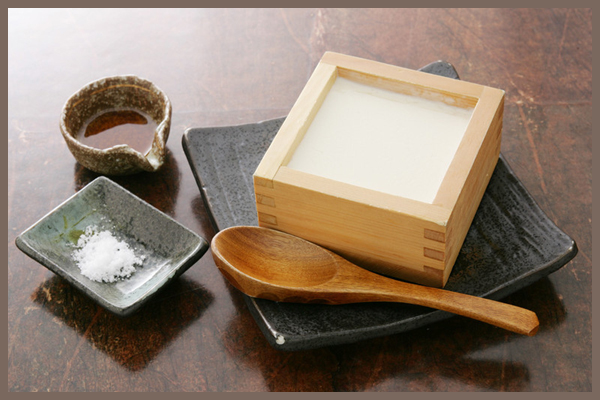
masudoofu マス豆腐 / 枡豆腐 Tofu in a wooden Masu cup.
. Rokusan 六三 伝説 legends about Rokusan, deity of illness .
......................................................................................... Tokushima 徳島県
一宇村 Ichiu
hotokesan 仏さん
12月の初巳の日はミノヒといって、仏のお正月であるという。この日はオハカサンに竹を組んで注連縄を張り、お供えをして草履も置いておく。家で身内が集まって会食し、夜の12時を過ぎてから墓地に向かい、麦藁を燃やした火で炙った餅や豆腐を食べる。仏さんは藁火の明かりで、人々の様子を見ているとされた。
in other parts of Japan
mi no hi ミの日,ミウマ,タツミ
旧12月はじめの巳の日に仏壇に豆腐や餅を供える。四国でも各地により多少相違はあるが、この日は死霊が訪れてくる日だと信じていた。
......................................................................................... Tokyo 東京都
南多摩郡 恩方村 Tama, Ongata
お灸をすえた時には、豆腐を食べると灸熱を吸い込まれないという。
.......................................................................
新島村 Niijima village on the island of Niijima
runin 流人,enoki 榎
豆腐を買いに行った流人が、豆腐を盗んだかどで捕らえられて、首を斬られた。死に際して流人は、自分が死んだ後、墓地から榎が生えるであろうが、それは自分が潔白だったと言う証だと言い残した。そして生えた榎が「なぞの榎」だと言い伝えられている。
......................................................................................... Yamagata 山形県
鶴岡市 Tsuruoka
imi 忌 absention, ritual purification
黒川村の王祇祭で豆腐を作るとき、産死の忌の人が来ると豆腐が固まらないとされている。
......................................................................................... Yamaguchi 山口県
福栄村 Fukue
inugami 犬神 Dog Deity
犬神に憑かれると、寿司の味がわからなくなる、豆腐が水になる、もち米を搗いても餅にならないなどのことが起き、妬んだ人のことを口走る、雪中を駆け出す、妊婦が鳥を殺す、などの行動をとる。
. Inugami 犬神 "Dog Deity" .
:::::::::::::::::::::::::::::::::::::::::::::::::::::::::::::::::::::::::::::::::::::::::::::::::::::::::::::::::::::::::::::::::::::::::::::::::::::::::::::::::::::::::::::::::::
Yokai Database - tofu - 57 entries (00)
- source : Nichibun Yokai Database -
- reference -
. Tofu Kozo shared at PINTEREST .
Actor Onoe Waichi II as a Tôfu Buyer (Tôfukai) and
a One-Legged Ghost (Ippon ashi no obake)
Utagawa Kunisada (1786 - 1865)
:::::::::::::::::::::::::::::::::::::::::::::::::::::::::::::::::::::::::::::::::::::::::::::::::::::::::::::::::::::::::::::::::::::::::::::::::::::::::::::::::::::::::::::::::::

. - - - Join my Kappa friends on facebook ! - - - .
:::::::::::::::::::::::::::::::::::::::::::::::::::::::::::::::::::::::::::::::::::::::::::::::::::::::::::::::::::::::::::::::::::::::::::::::::::::::::::::::::::::::::::::::::::
. Curry カレー, karē, karee .
one of the most popular dishes in Japan
- CLICK for more photos ! -
:::::::::::::::::::::::::::::::::::::::::::::::::::::::::::::::::::::::::::::::::::::::::::::::::::::::::::::::::::::::::::::::::::::::::::::::::::::::::::::::::::::::::::::::::::
. - yookai, yōkai 妖怪 Yokai monsters - .
. Japanese Legends - 伝説 民話 昔話 – ABC-List .
. Mingei 民芸 Regional Folk Art from Japan .
. Kappa densetsu 河童伝説, Kappa minwa 河童民話 - Legends - Introduction .
. kozoo 小僧と伝説 Kozo, Legends about temple acolytes and youngsters .
- #tofukozo #tofukozoyokai #kozoo #kozo -
:::::::::::::::::::::::::::::::::::::::::::::::::::::::::::::::::::::::::::::::::::::::::::::::::::::::::::::::::::::::::::::::::::::::::::::::::::::::::::::::::::::::::::::::::::
[ . BACK to DARUMA MUSEUM TOP . ]
[ . BACK to WORLDKIGO . TOP . ]
:::::::::::::::::::::::::::::::::::::::::::::::::::::::::::::::::::::::::::::::::::::::::::::::::::::::::::::::::::::::::::::::::::::::::::::::::::::::::::::::::::::::::::::::::::












